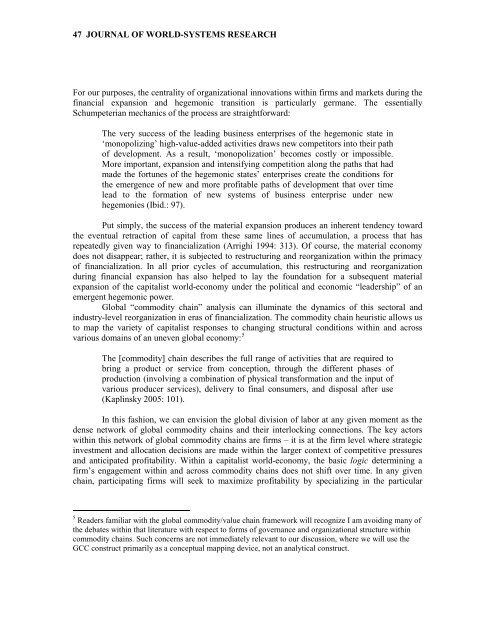Entire Volume 17 issue 1 - Journal of World-Systems Research ...
Entire Volume 17 issue 1 - Journal of World-Systems Research ...
Entire Volume 17 issue 1 - Journal of World-Systems Research ...
Create successful ePaper yourself
Turn your PDF publications into a flip-book with our unique Google optimized e-Paper software.
47 JOURNAL OF WORLD-SYSTEMS RESEARCH<br />
For our purposes, the centrality <strong>of</strong> organizational innovations within firms and markets during the<br />
financial expansion and hegemonic transition is particularly germane. The essentially<br />
Schumpeterian mechanics <strong>of</strong> the process are straightforward:<br />
The very success <strong>of</strong> the leading business enterprises <strong>of</strong> the hegemonic state in<br />
‘monopolizing’ high-value-added activities draws new competitors into their path<br />
<strong>of</strong> development. As a result, ‘monopolization’ becomes costly or impossible.<br />
More important, expansion and intensifying competition along the paths that had<br />
made the fortunes <strong>of</strong> the hegemonic states’ enterprises create the conditions for<br />
the emergence <strong>of</strong> new and more pr<strong>of</strong>itable paths <strong>of</strong> development that over time<br />
lead to the formation <strong>of</strong> new systems <strong>of</strong> business enterprise under new<br />
hegemonies (Ibid.: 97).<br />
Put simply, the success <strong>of</strong> the material expansion produces an inherent tendency toward<br />
the eventual retraction <strong>of</strong> capital from these same lines <strong>of</strong> accumulation, a process that has<br />
repeatedly given way to financialization (Arrighi 1994: 313). Of course, the material economy<br />
does not disappear; rather, it is subjected to restructuring and reorganization within the primacy<br />
<strong>of</strong> financialization. In all prior cycles <strong>of</strong> accumulation, this restructuring and reorganization<br />
during financial expansion has also helped to lay the foundation for a subsequent material<br />
expansion <strong>of</strong> the capitalist world-economy under the political and economic “leadership” <strong>of</strong> an<br />
emergent hegemonic power.<br />
Global “commodity chain” analysis can illuminate the dynamics <strong>of</strong> this sectoral and<br />
industry-level reorganization in eras <strong>of</strong> financialization. The commodity chain heuristic allows us<br />
to map the variety <strong>of</strong> capitalist responses to changing structural conditions within and across<br />
various domains <strong>of</strong> an uneven global economy: 5<br />
The [commodity] chain describes the full range <strong>of</strong> activities that are required to<br />
bring a product or service from conception, through the different phases <strong>of</strong><br />
production (involving a combination <strong>of</strong> physical transformation and the input <strong>of</strong><br />
various producer services), delivery to final consumers, and disposal after use<br />
(Kaplinsky 2005: 101).<br />
In this fashion, we can envision the global division <strong>of</strong> labor at any given moment as the<br />
dense network <strong>of</strong> global commodity chains and their interlocking connections. The key actors<br />
within this network <strong>of</strong> global commodity chains are firms – it is at the firm level where strategic<br />
investment and allocation decisions are made within the larger context <strong>of</strong> competitive pressures<br />
and anticipated pr<strong>of</strong>itability. Within a capitalist world-economy, the basic logic determining a<br />
firm’s engagement within and across commodity chains does not shift over time. In any given<br />
chain, participating firms will seek to maximize pr<strong>of</strong>itability by specializing in the particular<br />
5 Readers familiar with the global commodity/value chain framework will recognize I am avoiding many <strong>of</strong><br />
the debates within that literature with respect to forms <strong>of</strong> governance and organizational structure within<br />
commodity chains. Such concerns are not immediately relevant to our discussion, where we will use the<br />
GCC construct primarily as a conceptual mapping device, not an analytical construct.





